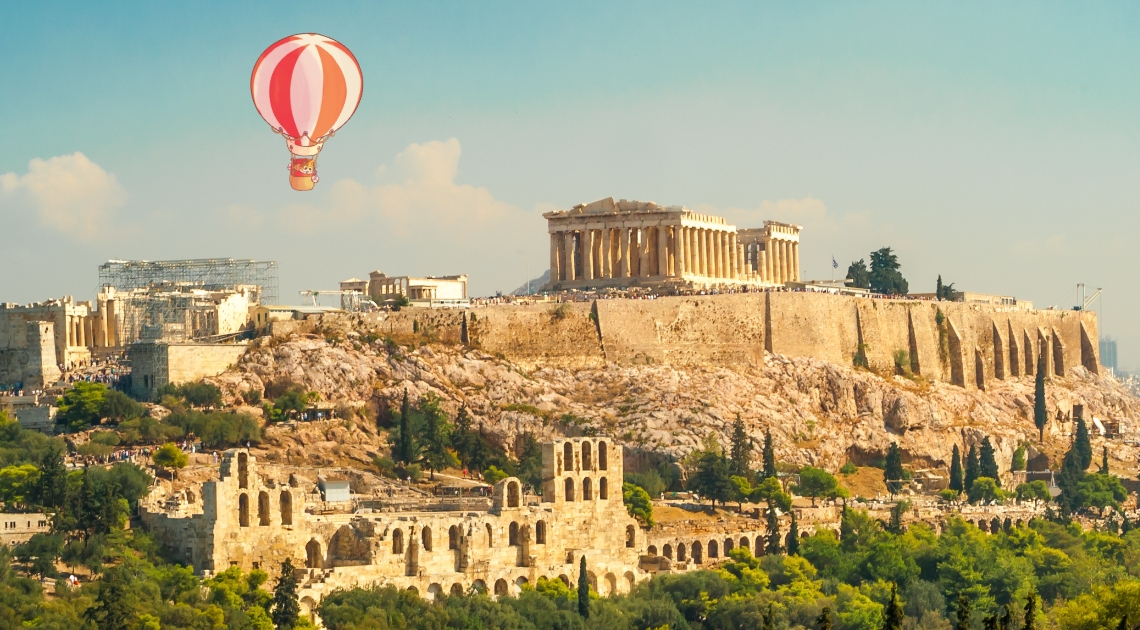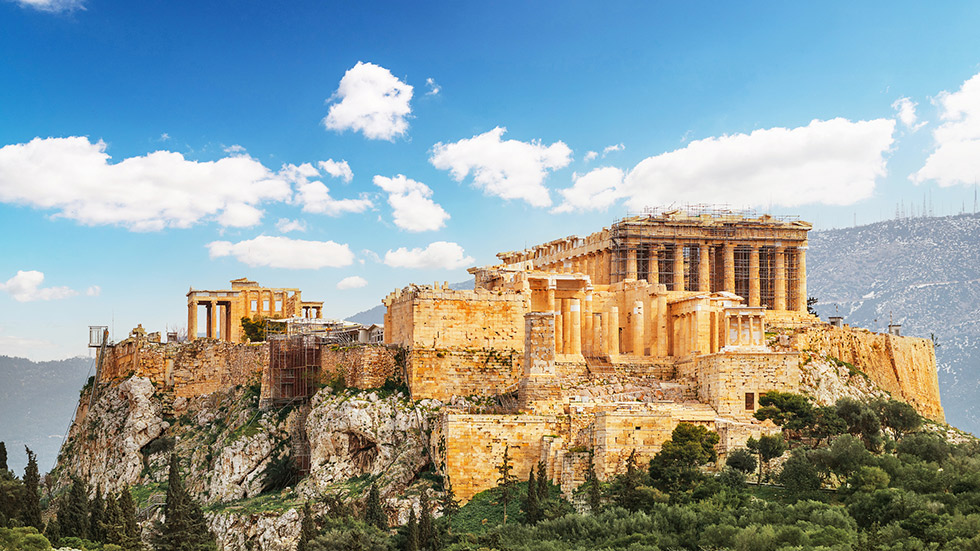Athens, Greece with Kids: Where Ancient History Comes Alive
KeeKee, AAA’s Family Travel Mascot, Shares Her Athens Favorites for Families


Where else can your children walk in the footsteps of ancient Olympians, stand where democracy was born, and see the temples they've read about in Percy Jackson books? The city makes ancient history tangible and exciting for children. Athens isn't just a city of ruins and museums – it's a living, breathing time machine where mythology springs to life and every street corner holds a story. There aren’t many places you can visit that are 7,000 years old.
While many parents might wonder if Athens is too "historical" for young travelers, you'll be pleasantly surprised to discover that the capital of Greece expertly blends ancient wonders with modern family fun. From interactive mythology tours to hands-on archaeological activities, Athens transforms what could be a dry history lesson into an exciting adventure that both parents and kids will treasure.
The city is easy to get around, and there is so much to see and do within a small walkable area. Everyone will enjoy the laidback Mediterranean lifestyle, and Greeks adore children. You'll find this warmth everywhere you go. Restaurants welcome young diners with open arms, museums offer family-oriented programs, and many sites have special activities for kids.
Here are KeeKee’s favorite things for families to do and see in Athens.
Athens’ Crown: The Acropolis and Parthenon
High on the hill in the middle of the city stands the heart of Athens, the Acropolis, dating back to the 5th century B.C. Acropolis means ‘high city.’ Crowning the Acropolis and visible all over town is The Parthenon, a 2,500-year-old ancient temple.
The Parthenon is one of the most famous buildings in Greece and the world. It was originally a temple dedicated to the Greek goddess Athena, and the city of Athens is named after her. The Parthenon is the largest Doric temple in Greece (100 feet x 228 feet) and took just nine years to build. Seeing it in person is breathtaking.
There is so much to explore on the Acropolis in addition to the Parthenon, like the Theatre of Dionysus. It’s the world’s first theater, dating back to the sixth century B.C., and dedicated to Dionysus, the god of plays and wine. Tragedies and comedies by playwrights like Sophocles were performed here. It could seat 17,000 people.
If you’re a family who loves to understand history and backstory, consider hiring a family-focused guide who can bring the ruins to life with stories and games.
For amazing views of the Parthenon and 306-degree views across Athens, take the leisurely stroll to the top of Philopappos Hill, known as “the hill of muses.”

Ancient Treasure: The Acropolis Museum
This incredible modern museum brings ancient history to life. The adventure begins before you even step inside, as you walk across glass floors revealing ancient ruins beneath their feet.
Children are fascinated by the museum's approach to archaeology, with exhibits showing how broken sculptures are discovered, cleaned, and pieced together like giant puzzles. Everyone will love the gallery of everyday life, featuring ancient toys, games, and items that help them imagine life as a child in ancient Athens. You can even visit an archaeological excavation beneath the museum.
The top floor café provides amazing Parthenon views and kid-friendly menu options.
The museum offers specially designed family backpacks with fun activities and games that turn young visitors into history detectives. They also have family workshops where children can try ancient crafts or participate in mythological storytelling sessions.
Athens’ Town Square: The Ancient Agora
At the base of the Acropolis sits the Ancient Agora, which means “gathering place.” This was once the heart of ancient Athens and the center of public life for ancient Athenians, a bit like a major town square of today.
Democracy was invented here. And Socrates preached here. It’s now a fascinating archaeological site.
Stoa of Attalos was the first-ever shopping mall. It has 45 Doric columns on the ground floor and today houses a museum with all the finds from the Agora.
The Temple of Hephaestus, built in 449 B.C., is the best-preserved Classical temple in Greece and the only temple in the ancient Greek world with a completely intact roof.
This is also a great place to have a family-friendly guide.

The Gods’ Neighborhood: Plaka
Outside the Agora, partially built into the rocks of the Acropolis, is Plaka, the old section of Athens that was once considered the neighborhood of the Olympic gods.
You can feel the history by strolling the narrow, winding streets full of houses, ancient monuments, shops, and tavernas.
Standing Tall: The Temple of Olympian Zeus
At one time, it was the largest temple in Greece. Now, only 16 of the original 104 columns remain. Started in the 6th century B.C., it took 700 years to finish in 132 A.D.
The massive columns demonstrate ancient Greek architecture's grand scale. It’s a great opportunity to learn about Greek mythology through engaging stories about Zeus, the king of the Olympian Gods.
Pomp & Precision: Changing of the Guard at Syntagma Square
The hourly changing of the Presidential Guard (Evzones, a special infantry of the Greek Army) at Constitution Square is a must-see that captivates children and adults. They guard the Tomb of the Unknown Warrior.
The Evzones are famous for their skirts (400 pleats symbolizing each year of the Turkish/Ottoman occupation), pom-pom shoes, and slow, high-legged, synchronized marching.
The grand ceremony, which features the full guard and official band, occurs on Sundays at 11 a.m. It’s free and takes place rain or shine. Arrive 15 minutes early for a good viewing spot, especially for the Sunday ceremony.

Where Modern Olympics Began: Panathenaic Stadium
Built in 329 BC for the athletic competitions of Panathenaia (the major festival honoring patron goddess Athena), it was also home to The Opening Ceremony for the first modern Olympic Games in 1896. It’s now where the Olympic flame handover ceremony occurs before every Olympic Games.
Known as Kallimarmaro, which means “beautifully marbled,” it is the only major stadium in the world built entirely of white marble.
You can visit the historic archaeological site and even run like an Olympic athlete on the field.
Athens’ High Point: Mount Lycabettus
Visit Lycabettus Hill (lie-kuh-BET-us), the highest point in the center of Athens, for the best views of the city stretching to the Aegean Sea. According to mythology, Athena built the hill when she dropped the limestone she was carrying to build the Acropolis.
The kids will love riding the Cable Car to the stop. In addition to the views, you’ll find the beautiful Saint George Chapel at the top, a 3,000-seat theater, and many options for food and drink.
See the Sea: Athens Riviera
Just 10 miles from central Athens and less than 30 minutes to reach, you’ll find the Athens Riviera, which has 40 miles of coastline stretching from Piraeus Port to the Temple of Poseidon at Sounio. It provides a great opportunity to incorporate beach time into your Athens visit.
There are over 20 beach clubs along the beaches, from casual, family-friendly to upscale options like Astir Beach Club, where you’ll find the 6th century B.C. Temple of Apollo Zoster. They are great places to relax and swim in the calm Aegean Sea.
Tips for Family Visits
May through June and September are ideal months to visit, as the temperatures are perfect and there are fewer crowds. No matter the time of year you visit, book tours and workshops in advance. Be sure to work with a travel advisor to help you plan great behind-the-scenes and hands-on activities.
Athens isn't just a history lesson – it's an adventure that will capture your family's imagination and create memories to last a lifetime. This remarkable city, where ancient wonders stand alongside modern family fun, is an incredible vacation destination that deserves a spot at the top of your family's travel list.
Athens Adventure Awaits!
